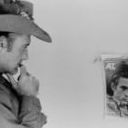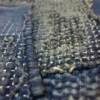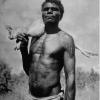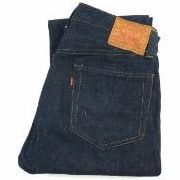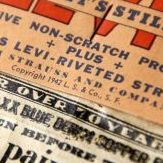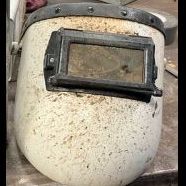Leaderboard
Popular Content
Showing content with the highest reputation on 07/25/25 in all areas
-
19 points
-
19 points
-
16 points
-
15 points
-
11 points
-
11 points
-
9 points
-
9 points
-
Disclaimer: following is google translate from the book, so possibly some thing is lost in translation. This happened after the armistice between the Korean and Japanese wars, so it is outside the scope of this book, but in February 1955, the industry's standards for denim weight suddenly changed. The specifications of denim haven't changed, the calculation method has changed. According to Figure C5-1 in the newspaper, the area of denim fabric, "28 inches wide x 36 inches long" (=0.78 x 1.0 yard), was previously used as the standard for weight (ounces), but this was changed to "36 inches wide x 36 inches long" (=1.0 x 1.0 yard). The newspaper emphasized that there was no change in the fabric itself. It seems that both workwear manufacturers and denim manufacturers responded to this change at the same time. Until then, denim manufacturers had used a 28-inch woven width as the standard, and it seems that they had customarily used the old standard value of "28 x 36 inches" (=0.78 x 1.0 yard) because it was easy to manage on site. As time passed, the performance of looms improved and wider denim could be woven, so it may have been unified into a new standard value of "36 x 36 inches" (= 1.0 x 1.0 yard) which is easier to convert for denim with different woven widths. After the Korean War ended in a ceasefire, denim production increased and various types of denim began to circulate, and February 1955 was the time when the industry standardized the labeling system. Looking at advertisements from workwear manufacturers at the time, we can see that starting in February 1955, denim weights gradually changed from "9-10 ounces" to "13-14 ounces" (Lee, Wrangler, Montgomery Ward, Sreas, J.C. Penney, and others also changed). It seems likely that Levi's 501XX guarantee tickets also changed from "10 ounces" around this time. Also, in "Lee Riders Lot 101 (c.1955)" (see page 29), which is shown at the beginning of this book, As mentioned above, flashers marked 133/4 ounces were later labeled "SQUARE YARD WEIGHT." One wonders whether this sudden change caused any confusion in the workwear industry, but it appears that nothing unusual occurred. For example, in 1951, seven major denim manufacturers gathered under the name of the Denim Advice Committee, again at the urging of the Office of Price Stabilization, a new organization very similar to OPA. Since the heads of each manufacturer had an opportunity to meet, it probably didn't cause any problems for the industry to change the ounce notation for denim all at once. I had noticed that the weight of postwar denim had increased over time, but I had assumed that denim had become heavier because of more advanced looms. I was surprised to find that it was simply the surface area being measured that had become larger. Ed Cray's statement on page 134 that "denim weight has increased to 13.5 ounces" is probably referring to the weight after the weight standard changed. I think Cray heard about this in an interview with someone from Levi's, but the person he was interviewing probably didn't know when the weight had increased. Although this is a double standard, both values were actually listed in the official denim specifications published in 1925. Table C5-2 is the specification sheet for unshrunk denim and includes weight data, warp and weft thread counts (per inch), and tear strength. There are two types of ounces for "Weight" in this table. The left side (Per square yard) is the weight in ounces of "1.0 x 1.0 yard", and the right side (Per linear yard, 28 inches wide) is the weight in ounces of "0.78 x 1.0 yard". Incidentally, the number for "Yards per pound, 28 inches wide" is the length in yards per 28 inches of denim x 1 pound (= 16 ounces). As you can see, even before the war, there were various ways of expressing weight according to the workplaces where denim was made. These official specifications were subsequently revised in 1929, 1931, 1936, 1944, and 1961, but all of them basically contained the same several different ways of expressing weight. However, despite the existence of these specifications, I have never seen any pre-1955 workwear or denim manufacturer product documentation that explicitly states that the ounce standard is "square yards" (of course, I may just not be able to find it). And there is one more mystery. In fact, if you convert the numbers in this table of the old and new denim values into the area of the denim, the numbers don't match when the width of the denim is 28 inches. This is true when the width is 28.8 inches. There seems to be an undiscovered truth to this problem. The nominal 28 inches may have actually been 28.8 inches. Snippets & table used in the above column:8 points
-
8 points
-
5 points
-
4 points
-
3 points
-
3 points
-
Very interesting. That would answer the question, if I understood it correctly. My TLDR: Before the fabric was categorized by the weight of one piece with the dimensions of 28x36 inches. Then in 1955 this was changed to a larger fabric of 36x36". Of course, a larger fabric is heavier. And the increase is by 8", which is nearly 30%. So 10 ounce x 1.3= 13 ounce.2 points
-
2 points
-
2 points
-
2 points
-
2 points
-
2 points
-
2 points
-
2 points
-
They are made by https://www.shinotex.jp/en/ The original maker from 30 years ago. With the help of Ueki-san who was responsible for Gardener back in the day. The denim is from Collect Mills1 point
-
1 point
-
1 point
-
1 point
-
1 point
-
1 point
-
1 point
-
Thanks @lehadrakon for the great communication and totally painless trade. Couldn't ask for it to be smoother1 point
-
1 point
-
1 point
-
1 point
-
1 point
-
1 point
-
1 point
-
1 point
-
1 point
-
1 point
-
1 point
-
1 point
-
1 point
-
1 point
-
1 point
-
Envious of you lot that can wear denim jackets in June! These spent about 8 hours in the Texas sun (chilly day here, only 91 F / ~32 C) and they're bone dry now. Starting to see a little marbling pop up. They'll go back on the legs tomorrow.1 point
-
1 point
-
1 point
-
1 point
-
1 point












